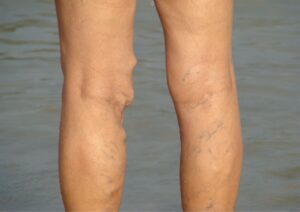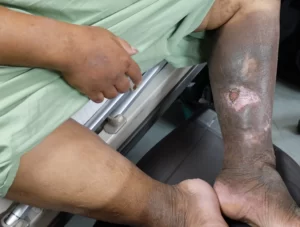Stasis dermatitis, also known as venous stasis dermatitis, varicose eczema, or gravitational dermatitis, is a skin condition that occurs in people with chronic venous insufficiency. This condition is characterised by inflammation, itching, and discoloration of the skin, typically in the lower legs. Understanding stasis dermatitis is essential for managing its symptoms and preventing complications.
What Causes Stasis Dermatitis and Venous Insufficiency?
Stasis dermatitis is primarily caused by poor blood circulation in the veins of the lower legs. Advanced chronic venous insufficiency is a significant underlying condition. When the veins cannot effectively push blood back to the heart, it can lead to blood pooling and increased pressure in the lower extremities. Several factors can contribute to this condition:
Chronic Venous Insufficiency: The primary cause of stasis dermatitis, where the valves in the veins are damaged or weakened, often leading to varicose veins.
Deep Vein Thrombosis (DVT): Blood clots in the deep veins can damage the vein valves and lead to venous insufficiency.
Obesity: Excess weight puts additional pressure on the veins in the legs.
Prolonged Standing or Sitting: Occupations or lifestyles that involve long periods of standing or sitting can worsen venous insufficiency.
Age: As people age, the risk of developing venous insufficiency and stasis dermatitis increases.
Genetics: A family history of venous disorders can increase the risk.
Risk factors for developing stasis dermatitis include older age, female sex, pregnancy, obesity, prolonged periods of sitting or standing, high blood pressure, heart failure, kidney failure, chronic edema, history of cellulitis, varicose veins, history of blood clots in the legs, leg vein surgeries, leg injuries, and family history of venous disease.
Symptoms of Stasis Dermatitis
The symptoms of stasis dermatitis can vary, but they often include:
Swelling (Edema): Swelling in the lower legs and ankles, especially after prolonged standing or sitting.
Itching and Redness: The affected skin may become itchy, red, and irritated.
Discoloration: The skin can develop a brownish or reddish discoloration, particularly around the ankles.
Thickened Skin: The skin may become thickened, leathery, and scaly.
Pain or Heaviness: The legs may feel achy, heavy, or tired.
Open Sores or Ulcers: In severe cases, venous ulcers can develop, which are slow-healing wounds on the lower legs.
Severe stasis dermatitis can lead to significant skin changes such as thickening, hardening, darkening, or a bumpy appearance, and may also result in leg ulcers.
Diagnosis of Stasis Dermatitis
Diagnosing stasis dermatitis typically involves a physical examination and a review of the patient’s medical history. The proliferation of dilated blood vessels in the affected skin is a key diagnostic feature. Additional tests may include:
Duplex Ultrasound: This imaging test helps visualize blood flow in the veins and detect any blockages or valve dysfunction.
Patch Testing: To rule out contact dermatitis or other skin conditions.
Treatment Options for Varicose Veins
Stasis dermatitis treatment focuses on improving blood flow, reducing inflammation, and preventing complications. Treatment options include:
Compression Stockings: Wearing compression stockings helps improve blood flow and reduce swelling by applying gentle pressure to the legs.
Topical Steroids: Topical corticosteroids can help reduce inflammation and itching.
Moisturizers: Regular use of emollients can keep the skin hydrated and reduce dryness and scaling.
Elevation: Elevating the legs above heart level several times a day can help reduce swelling.
Medications: Diuretics may be prescribed to reduce swelling, and anticoagulants can help prevent blood clots.
Treating Underlying Conditions: Managing chronic venous insufficiency or other underlying conditions, such as venous eczema, is crucial.
Good Skin Care: Keeping the skin clean and moisturized, and avoiding trauma to the skin, can prevent infections and complications.
Risk Factors and Preventing Stasis Dermatitis
Preventing stasis dermatitis involves managing the underlying causes and adopting healthy lifestyle habits:
1. Stay Active: Regular exercise, such as walking, can improve circulation.
2. Maintain a Healthy Weight: Weight management can decrease the pressure on your veins.
3. Avoid Prolonged Sitting or Standing: Take breaks to move around if your job requires long periods of sitting or standing.
4. Wear Compression Stockings: Especially if you are at risk or start experiencing symptoms.
5. Elevate Your Legs: Elevate your legs above your heart level several times a day to reduce swelling.
Conclusion
Stasis dermatitis is a manageable condition with the right approach to treatment and prevention. By understanding the causes, recognizing the symptoms, and seeking appropriate medical care, you can effectively manage stasis dermatitis and maintain a healthy quality of life. If you suspect you have stasis dermatitis, consult with a healthcare professional to develop a personalized treatment plan.










